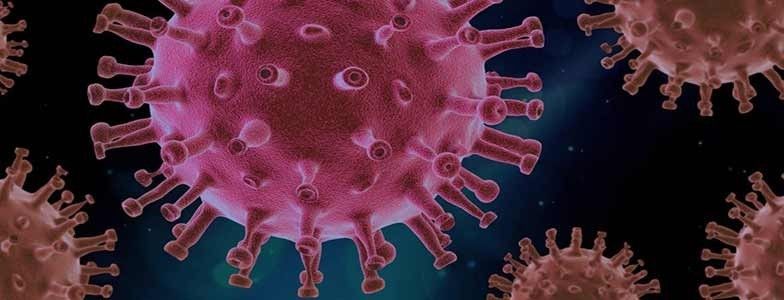On March 6, 2020 the first person (patient zero) in Peru - a 25-year old Latam Airlines employee who visited Spain, France and the Czech Republic in February - was tested positive for SARS-CoV2. With this Corona officially arrived in Peru. As was to be expected numbers of infected rose quickly over the past 10 days.
Taking the spreading of the virus, chaotic states in hospitals and deaths in other countries, the state of the public Peruvian healthcare sector and the fragile health of many Peruvians into account, President Martin Vizcarra had to act quickly. And he did – however some criticized that his measures were over the top, will ruin the economy and bring Peru and its citizens to the breaking point while others accused him of only reacting to the approaching health crisis and this too late and not firmly enough.
Anyway, first infected and their contact persons (at least those that could be identified) were put in quarantine. With numbers climbing Vizcarra announced on March 11 a series of measures to stop the spreading of the virus. Those included postponing the beginning of the new school year after the summer vacation to March 30 (usually the school year in Peru starts around March 1) and isolate travelers who come from China, Spain, France and Italy for 14 days.
Only a day later, on March 12, a Public Health Emergency was declared for 90 days and the Peruvian Ministry of Health was asked to put an action plan to contain the spreading of the virus into effect within the next 72 hours.
On March 13, the country suspended the arrival of all flights originating in Asia and Europe with immediate effect; according to the newly created Corona crisis team the first step of preventive measures to stop the spreading of the virus.
Now yesterday, March 15, the Peruvian President declared in a speech on TV a State of Emergency beginning Monday, March 16 at 11.59 pm - for now for the coming 15 days.
The State of Emergency includes the following regulations and restrictions
- All borders are closed and all international and national travel by air, land, sea and river is suspended. How this is supposed to work out for the thousands of tourists who are currently visiting Peru is unclear. Those affected should get in contact with their tour operator, airline or even embassy immediately to find out if there is a chance to get out of Peru or if they are stuck in the country for at least the next 15 days (most probably even longer).
- All work in the public and private sector is suspended; exception: essential activities and services.
- In general, all citizens must stay home (quarantine for everyone) and are only allowed to leave their house / apartment for essential activities such as buying food or medical products, visit a doctor, hospital, bank or insurance company.
- The Peruvian government ensures a sufficient supply of food and medications as well as the perpetuation of essential services such as electricity, water, gas, fuel, telecommunication, funerals and waste collection.
In case you have symptoms of Covid 19, for your own safety and those of others please do NOT visit one of the crowded hospitals. Call 113, send a WhatsApp to 952 842 623 or write an e-mail to infosalud[at]minsa.gob.pe.
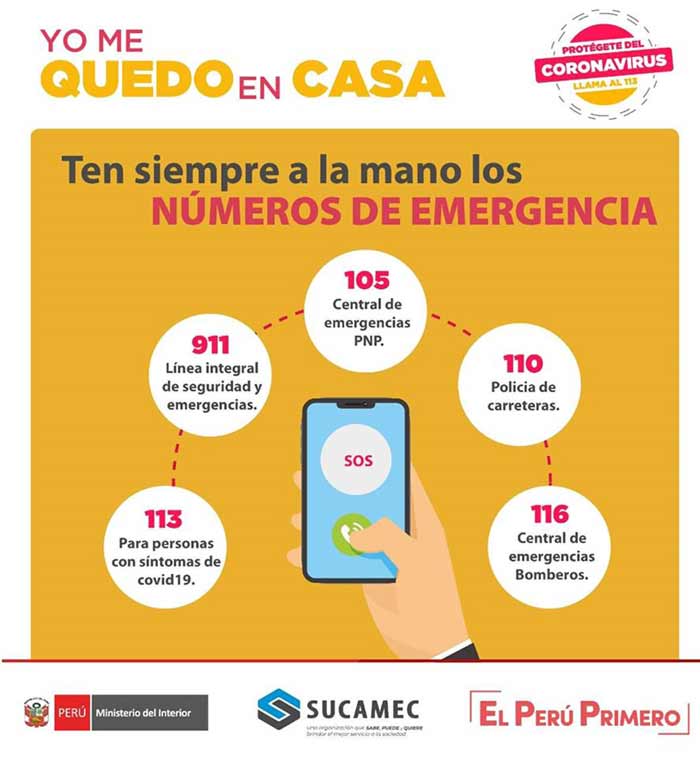
Update March 18, 2020: Tightened restrictions and curfew
Today the Peruvian President tightened the restrictions and declared a nationwide curfew from 08.00 pm to 05.00 am which will be enforced by police and military. During these hours only authorized persons and vehicles with a special permit are allowed to be out on the streets.
It sounds ridiculous, but a pedestrian who is out on the street during the curfew due to an emergency must carry a white handkerchief or other white object (perhaps a piece of toilet paper?); unauthorized cars on the street during the curfew are only allowed to drive less than 30 km/ h and must have the interior lighting switched on.
Be aware that during the normal hours (so from 05.00 am to 08.00pm) you are still only allowed to leave your home for essential activities such as buying food or medical products, visit a doctor, hospital, bank or insurance company.
Additionally, starting tomorrow, March 19, only private vehicles with a special permit are allowed to drive during the normal hours from 05.00 am to 08.00 pm.
Furthermore, the situation for tourists is anything but good. Thousands are stuck in Lima, Cuzco and other areas of Peru struggling with canceled national and international flights, hotels closing and somehow getting out of Peru and home.
Update March 22, 2020: Jorge Chavez International Airport closed
Since the declaration of the state of emergency in Peru more than 9,000 people could leave the country from Jorge Chavez International Airport in Callao. But now it seems to be over for all those visitors still in Peru. Airport authorities announced that the airport was closed today completely and stays closed for the entire duration of the state of emergency. From now on the Peruvian State is in charge of scheduling possible flights which will be handled exclusively by the Grupo 8 of the Peruvian Air Force. What a setback for all those still stuck in Peru.
Update March 26, 2020: Evacuations flights for tourist stuck in Peru
Over the past few days numerous countries through their embassies in Lima tried to negotiate with the Peruvian authorities evacuation flights for their citizens. Even though regulations and measures were extremely strict a few foreigners could finally get home; but unfortunately others, especially those being in the provinces are still stuck. Let’s hope more flights will be allowed.
As the enforcement and monitoring of the regulations of the Peruvian state of emergency is in the hands of the National Police and the military from which many tested positive for SAS-CoV2 and therefore can’t work anymore, President Martin Vizcarra mobilized reservists of the last three generations.
And one good thing in all this mess: Lima, usually one of the Latin American capitals with the highest air pollution which suffocates in traffic, experiences clean air (a reduction of over 50% of pollutants), clear skies and quiet due to nearly no cars on the streets.
Update April 1, 2020: State of emergency extended
With infection numbers on the rise, Peru extended the state of emergency for another 15 days and tightened the curfew. In the regions of Tumbes, Piura, Lambayeque, La Libertad and Loreto people are banned on going out from 04.00 pm to 05.00 am, while in the rest of the country Peruvians are confined to their homes from 06.00 pm to 05.00 am.
Additionally, from April 3 to 12, 2020 men are only allowed to go outside on Monday, Wednesday and Friday from 05.00 am to 06.00pm / 04.00 pm only for essential activities, women on Tuesday, Thursday and Saturday. On Sunday all have curfew the whole day.
While first it was announced that the Metropolitano in Lima suspends their service, starting today busses will run on the main and feeder routes from 05.30 am to 06.00 pm.
Update April 6, 2020: Easter under quarantine and other changes
Easter is around the corner and we just heard that the curfew is extended; Holy Thursday (April 9) and Good Friday (April 10) as well as Easter Sunday (April 12) we all have to stay at home.
Over the past days the first severe effects of the complete lockdown of the country became obvious. Many people, especially those that lead a hand-to-mouth-existence struggle to feed their families. The government tries to ease the pain with distributing staple foods to most affected, but many come away empty-handed.
Additionally, a few especially vulnerable Peruvians receive financial support of S/ 380 (a little over US$ 110).
And the government further discusses at the moment if employees can withdraw up to S/ 2,000 from their CTS (Peru's Working Compensation, a benefit usually paid twice a year) and 25% or max. 12,000 Soles from their AFP (Pension Fund). So, everything looks like we are in it for a much longer time.
Unfortunately, still thousands of tourists are stuck in Peru and their embassies work on organizing evacuation flights. Hang in there.
Update April 10, 2020: State of emergency extended
Once again, the state of emergency was extended; this time until April 26, 2020 and many fear
that once we are there it will be extended until May. Not sure how long Peru and its citizens can make it. Anyway, with this new extension come new regulations which go into effect tomorrow April 11:
- In the regions of Tumbes, Piura, La Libertad and Loreto people are banned on going out from 04.00 pm to 04.00 am, while in the rest of the country Peruvians are confined to their homes from 06.00 pm to 04.00 am.
- During the normal hours (so from 04.00 am to 06.00pm / 04.00pm) only essential activities are allowed, however only one person per family is allowed to go out.
- The ridiculous gender segregation is lifted.
- It is obligatory to use a face mask in public.
- Sunday remains curfew for all for the whole day
And as we got some questions regarding taking dogs out for a walk here the rules:
Walking a dog during curfew (06.00 pm / 04.00 pm to 04.00 am) is prohibited. During normal hours walking a dog is allowed under the following restrictions:
- The owner must use a face mask
- The walk should be as short as possible and only in immediate vicinity of the home
- Adequate distance to others should be kept
Update April 18, 2020: Lockdown and its side effects on people
After just one months of state of emergency and the complete lockdown of Peru the negative effects especially for the poor become visible. 4 days ago an estimated 500 to 600 people - mostly mothers with children and elderly - who lived and worked in Lima, left the Peruvian capital to walk (!) to their home regions of Junin and Huancavelica (approx. 300 to 450 km). When stopped by police and military about 20 km from Lima, they told officials that due to the lockdown they lost their jobs / income, had no financial reserves, no food and some were evicted from their homes by their landlords as they couldn’t pay rent anymore. They only wanted to get home, where they have relatives, could get food and at least survive. After some discussion busses were organized and the people brought home to their home regions.
And as even officials had to admit that these people are only the tip of the iceberg, the Peruvian government initiated a program and organized kind of a bus shuttle service. Fulfilling certain criteria (stranded in another than the home region, registering under a newly created link by each regional government, SARS-CoV2 test before traveling, strict sanitary protocols during travel, quarantine after arrival provided by regional government, again testing before being allowed to leave quarantine) some Peruvians (!!!) can now leave Lima and get back to their home region. On their way back to Lima the busses take Peruvians from the provinces to the Peruvian capital.
Be aware that this “service” is only for Peruvians who are stranded in another than their home region and only offered for humanitarian reasons.
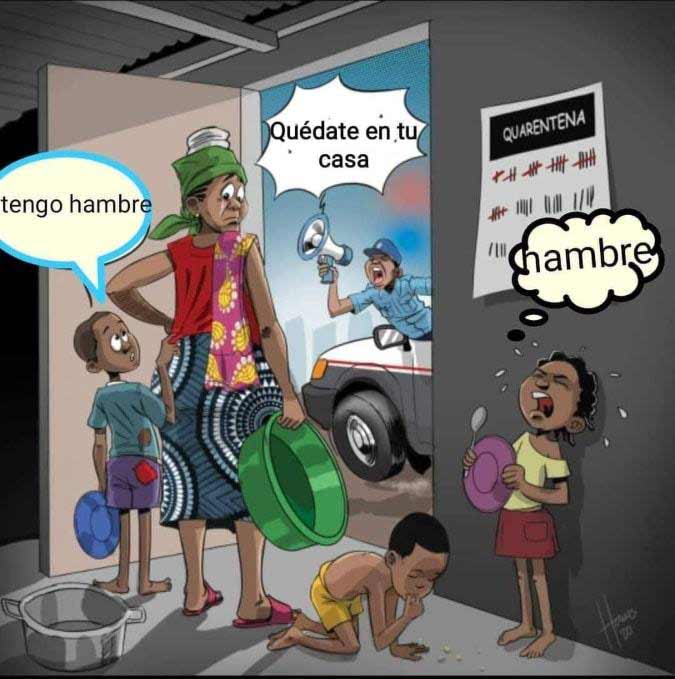
Update April 23, 2020: State of emergency extended
Some of us are starting to feel like Bill Murray in “Groundhog Day”. Today Peruvian President Martin Vizcarra extended the state of emergency for another 15 days until May, 10. All measures and regulations to fight the spread of the virus - which haven’t been very effective as numbers are climbing - stay in place. However, the President hinted at the possibility of gradually restarting activities in a controlled manner from May 4, 2020. Let’s wait and see …
To give the majority of families in this crisis (the government says that 75% of families in Peru will benefit) even the slightest chance to survive another two weeks without any income or option to earn a living, the Peruvian government pays a “Universal Family Bonus” of S/ 760 (about US$ 220). This “bonus” is aimed mainly at those living from day to day and those usually working in the informal sector.
Update April 24, 2020: Peru has a new Minister of the Interior
In the midst of the Corona crisis Peru’s Minister of the Interior Carlos Morán resigned. Today President Vizcarra has sworn in his successor in the Government Palace. The new Peruvian Minister of the Interior is Gastón Rodríguez Limo, a General of the Peruvian National Police.
Update April 26, 2020: Miraflores implements its own sanitary regulations
The district of Miraflores in Lima has now its own sanitary regulations. Citizens have to wear a mask and gloves when leaving the house. Additionally, all shops still open (mostly supermarkets) will take the temperature of shoppers at the entrance and allow only 50% of the usually allowed people enter. Failure to comply with this regulations can result in fines of up to S/ 1000.
Update April 29, 2020: Food baskets don’t reach the ones in need
To support families in need in this crisis the Peruvian government promised to support particularly affected citizens with food basket (“canastas”) containing at least basic staples. But as usual such trying times as the ones we are living through right now not only bring out the good in people, but often unfortunately the bad. Currently media reports are full of news about irregularities / corruption regarding the purchase of the food for these canastas. Additionally, it seems that numerous municipalities in Peru still only have distributed a tiny fraction of the available food aid to the needy. What a shame; the poor of the poor are once again the ones that suffer the most.
Update May 1, 2020: Migraciones waves overstaying fee
Good news for all foreigners on a tourist visa in Peru. Migraciones, even though not working at the moment as all government agencies in Peru, announced that due to the state of emergency and closed borders foreigners don’t have to pay a fine when overstaying their tourist visa (only applies to overstaying fees from March 16, 2020 until borders are opened again plus 30 days).
Update May 8, 2020: State of emergency extended
While gentle resistance (wanted or needed) against the measures to stop the spreading of the virus can be increasingly seen - people disobey the quarantine, curfew, social distancing, …. or in some newspaper articles can be found questioning if the proportionality - danger of virus and damage of measures on people and economy is taken into consideration at this point - today the state of emergency was extended for another 15 days until Mai 24. Numbers of infected are still on the rise, the economy is on its knees, many people have no income and their financial reserve are gone, and actually, no end of all of this in sight.
- Once again, the times for the nationwide curfew changed. In the regions of Tumbes, Piura, Lambayeque, La Libertad and Loreto people are banned on going out from 04.00 pm to 05.00 am, while in the rest of the country Peruvians are confined to their homes from 08.00 pm to 05.00 am.
- During the normal hours (so from 05.00 am to 08.00pm / 04.00pm) only essential activities are allowed, however only one person per family is allowed to go out.
- It is still obligatory to use a face mask in public.
- Sunday remains curfew for all for the whole day
- From Mai 18, 2020 children (0 – 14 years) accompanied by an adult are allowed to leave the house for the first time in 2 months for half an hour. No toys, no scooter or bicycle, no playground, no nothing, just walking and that not further away then 500m from home.
Update May 12, 2020 – Free access to archaeological sites
There might be light at the end of the tunnel; or am I just clutching at straws?
Anyway, today the Peruvian government announced that from July 1 to December 31, 2020 Peruvian public servants as well as children, adolescents and senior citizens – whether national or foreign – can enter all archaeological sites, historical places and natural areas managed and protected by the Peruvian Ministry of Culture and the National Service of Natural Areas free of charge.
Does this mean we may be released by July 1 and are allowed to travel again at least within Peru? Who knows.
Update May 16, 2020: National travel may begin in August, international in October
Yesterday the Peruvian Minister of Transport and Communication, Carlos Lozada, announced that national passenger transport by air and land may restart in July or August, when the country can enter phase 3 of the government’s economic recovery plan.
Unfortunately, the Minister as well confirmed that the borders remain closed for a few more months and the closure will only be lifted gradually in the last stage (phase 4) of the recovery plan. This means that international travel may only restart in October.
Update May 23, 2020: Quarantine extended until June 30
What a bummer. Yesterday Peruvian President Martin Vizcarra announced the extension of the quarantine until June 30, 2020, however with “modifications and flexibility”. Peru is now in phase 2 of the government’s economic recovery plan.
- The nationwide curfew changed again. In the regions of Tumbes, Piura, La Libertad, Lambayeque, Loreto, Ucayali, Ica and three provinces in Áncash (Santa, Casma and Huarmey) people are banned on going out from 06.00 pm to 04.00 am, while in the rest of the country Peruvians are confined to their homes from 09.00 pm to 04.00 am.
- During the normal hours only essential activities are allowed, however there is a gradual easing of restrictions.
- Except of supermarket most other shops remain closed, but online shopping for clothes, shoes, office supplies, school supplies and home appliances is allowed now. Furthermore, technicians such as electricians, plumbers, computer specialists and maintenance / repair personnel as well as hairdressers, cosmeticians, odontologists, vets and delivery services (Rappi, Uber Eats, Glovo) can start offering their services again.
- We are allowed to use our cars again, but only when shopping for food, medication and financial services and only and exclusively in the district where we live and only one person per car and with a special permit, the pase vehicular distrital. And those who still have a job to get to are allowed to use their car again, but as well only with a pase vehicular personal laboral.
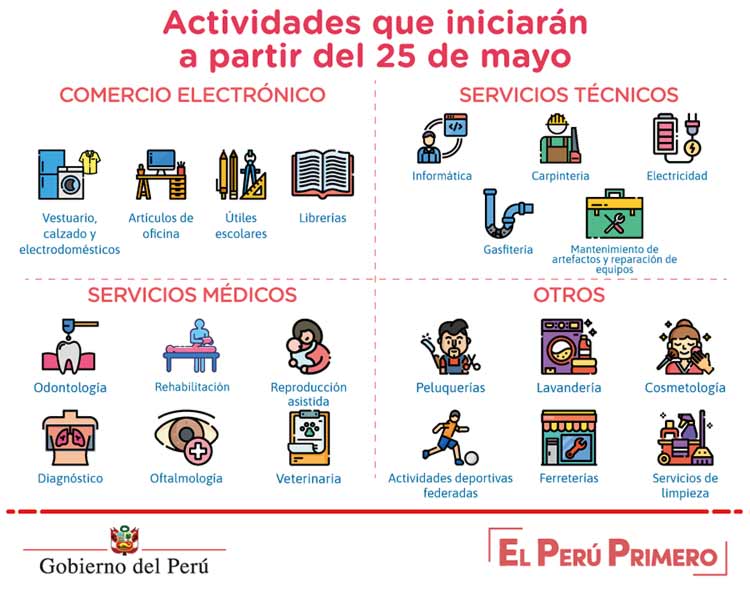
Update February 15, 2021: The never ending story ...
Over the past half year Peru saw a few ups (easing of restrictions) and many downs (tightening of restrictions). Today with case numbers on high levels, hospitals still - as usual even before Covid-19 - on the verge of collapse and fear of mutations spreading the Peruvian government extended the restrictions on international travel and on national quarantine rules until February 28, 2021
Officially the land borders are open, however crossing is restricted to Peruvians and residents. All flights from Europe and Brazil as well as all flights over 8 hours duration are suspended. To enter Peru a negative PCR or antigen test not older than 72 hours is required and an obligatory 14-day quarantine imposed on travelers.
Additionally the Peruvian government implemented a new set of restrictions on provincial level.
On “Extreme Alert” are the cities and towns mentioned here:
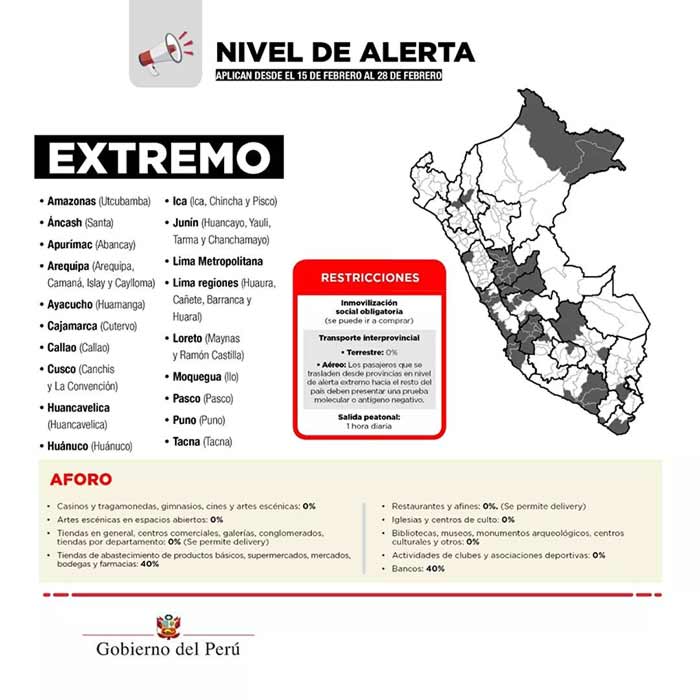
The "Extreme Alert" means obligatory social immobilization 24/7, leaving the house only for 1 hour per day during 06.00 am and 06.00 pm and only for essential activities such as food shopping, healthcare, financial services.
The following businesses are closed or can only operate with a limited capacity
- Casinos and slot machines, gyms, movie theaters, performing arts: closed
- Shops in general, shopping malls, galleries, department stores: closed
- Supermarkets, markets, bodegas, pharmacies: open with 40% capacity.
- Restaurants and similar (indoor or outdoor areas): closed, delivery allowed
- Churches and places of worship: closed
- Libraries, museums, archeological sites, cultural centers and others: closed
- Clubs and sports associations: closed
- Hairdressers, spas, barber shops, facial massages, manicures, make-up and other related activities: closed
- Banks and other financial institutions: open with 40% capacity.
- Interprovincial land passenger transportation: suspended
- Interprovincial air passenger transportation: negative antigen or PCR test required
- Transportation with private vehicles: prohibited (a special permit can be applied for)
On “Very High Alert” are the cities and towns mentioned here:
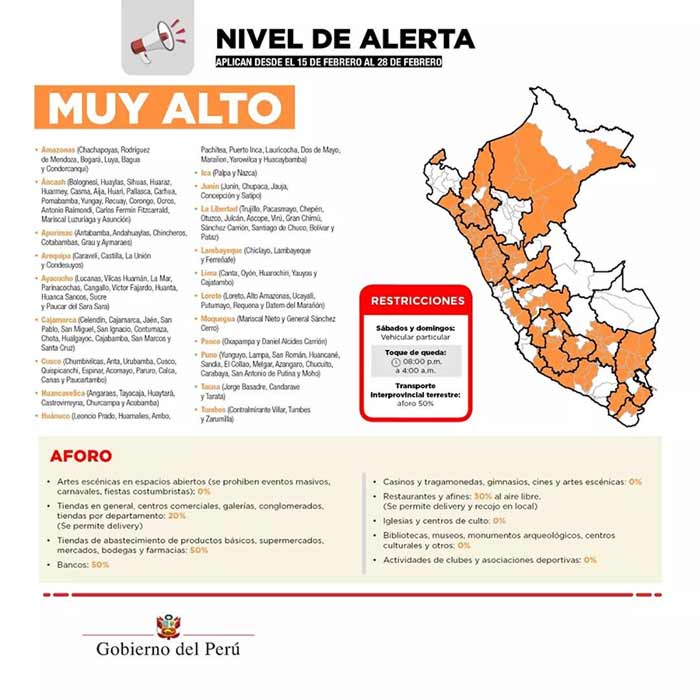
The “Very High Alert” means curfew from 06.00 pm to 04.00 am and the use of private vehicles is prohibited on Saturdays and Sundays
The following businesses are closed or can only operate with a limited capacity
- Casinos and slot machines, gyms, movie theaters, performing arts: closed
- Shops in general, shopping malls, galleries, department stores: open with 20% capacity
- Supermarkets, markets, bodegas, pharmacies: open with 50% capacity.
- Restaurants and similar (only outdoor areas): open with 30% capacity, delivery and pick-up allowed
- Churches and places of worship: closed
- Libraries, museums, archeological sites, cultural centers and others: closed
- Clubs and sports associations: closed
- Hairdressers, spas, barber shops, facial massages, manicures, make-up and other related activities: closed
- Banks and other financial institutions: open with 50% capacity.
- Interprovincial land passenger transportation: operating with 50%
- Interprovincial air passenger transportation: negative antigen or PCR test required
On “High Alert” are the cities and towns mentioned here:

The “High Alert” means curfew from 09.00 pm to 04.00 am and the use of private vehicles is prohibited on Sundays
The following businesses are closed or can only operate with a limited capacity
- Casinos and slot machines, gyms, movie theaters, performing arts: open with 30% capacity
- Shops in general, shopping malls, galleries, department stores: open with 40% capacity
- Supermarkets, markets, bodegas, pharmacies: open with 50% capacity.
- Restaurants and similar: open with 50% capacity indoors and 60% capacity outdoors, delivery and pick-up allowed
- Churches and places of worship: open with 20% capacity
- Libraries, museums, archeological sites, cultural centers and others: open with 50% capacity
- Clubs and sports associations: open with 40% capacity
- Banks and other financial institutions: open with 50% capacity.
- Interprovincial land passenger transportation: operating with 50% capacity
- Interprovincial air passenger transportation: negative antigen or molecular test required
On “Moderate Alert” are the cities and towns mentioned here:
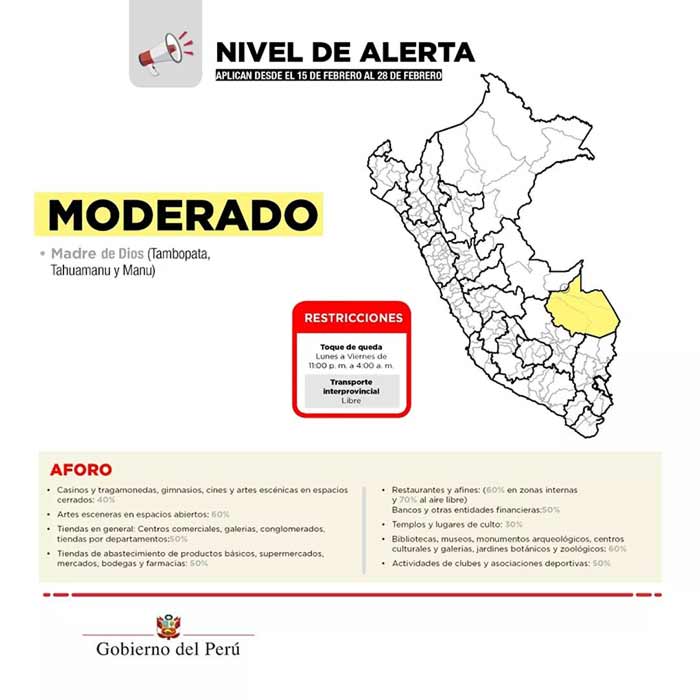
The “Moderate Alert” means curfew Monday to Friday from 11.00 pm to 04.00 am.
The following businesses are closed or can only operate with a limited capacity
- Casinos and slot machines, gyms, movie theaters, performing arts: open with 40% capacity
- Shops in general, shopping malls, galleries, department stores: open with 50% capacity
- Supermarkets, markets, bodegas, pharmacies: open with 50% capacity.
- Restaurants and similar: open with 60% capacity indoors and 70% capacity outdoors, delivery and pick-up allowed
- Churches and places of worship: open with 30% capacity
- Libraries, museums, archeological sites, cultural centers and others: open with 60% capacity
- Clubs and sports associations: open with 50% capacity
- Banks and other financial institutions: open with 50% capacity.
- Interprovincial land passenger transportation: operating freely
- Interprovincial air passenger transportation: negative antigen or PCR test required
Update February 15, 2021: Extension of State of Sanitary Emergency
Today El Peruano, the official state gazette, published the Supreme Decret No. 009-2021-SA, an extension of the original Decret No. 008-2020-SA, followed by No. 20-2020-SA, 27-2020-SA and 31-2020-SA announcing that the State of Sanitary Emergency, which should have ended at the beginning of March, is once again extended for another 6 months until September.

